A GILT COPPER ALLOY FIGURE OF VAJRABHAIRAVA TIBET OR MONGOLIA, 18TH CENTURY Himalayan Art Resources item no.13480 30.3 cm (11 7/8 in.) high Fußnoten The Gelug school of Tibetan Buddhism became the dominant religious order in Tibet and Mongolia in the 17th century, and was patronized by the Qing court throughout the 18th century. During this period, Vajrabhairava, one of the principal meditational deities of the Gelug school, gained tremendous popularity. This sizeable, powerful, and well-preserved gilt bronze, featuring a rare inclusion of a set of turquoise flaming jewels (triratna) on its base, is an outstanding sculpture of Vajrabhairava. Here, Vajrabhairava holds his consort with his primary hands, and powerfully extends his other thirty-two arms to form a massive plane. Each of his hands grasps a different ritual implement. The heavy mass is supported by his eight robust legs, crushing rows of meticulously delineated birds, animals, and subdued Hindu deities. In contrast, his consort Vajravetali appears lithe and petite, dissolving into his passionate embrace. A wrathful emanation of Manjushri, Vajrabhairava's ferocity is heightened by his array of fearsome heads, with the primary in the form of a furious buffalo, signifying his victory over Yama, the Lord of Death. The arrangement of his nine faces, with seven on the primary level and one on each of the upper levels, is an iconographic program commonly adopted by the Gelug tradition, while in the Sakya or Kagyu school the deity's nine faces are often evenly distributed among the three levels. Despite the complexity in form, each of his faces is finely detailed and skillfully joined together with a convincing sense of naturalism. The incised embellishment to the lotus petals is common to repoussé work of the 18th century found in Central Tibet (see Rhie & Thurman, Shrine for Tibet, New York, 2009, pp.66 & 140, nos.I-9a & III-2a). Also compare the figures with an earlier gilt bronze Vajrabhairava at the Museum Rietberg (see Uhlig, On the Path to Enlightenment, Zurich, 1995, p.170-1, no.114). Published Pratapaditya Pal, 'Bronzes of Nepal', in Arts of Asia, Vol.4, No.5, September-October, 1974, p.37, fig.11. Provenance Doris Weiner, New York, 3rd June 1969 Dorothy and Frank Neustatter, Los Angeles, 1969-2003 Christie's, New York, 27 March 2003, lot 62 Collection of Edwin and Cherie Silver, Los Angeles, 2003-2017 Thence by descent 銅鎏金大威德金剛像 西藏或蒙古,十八世紀 喜馬拉雅藝術資源網13480號 高30.3釐米(11 7/8英吋) 400,000-600,000港幣 十七世紀時,藏傳佛教的格魯派成為西藏和蒙古地區佔據統治地位的宗教力量,並在十八世紀持續受到清朝廷的冊封與欽賜。在此期間,格魯派重要本尊大威德金剛獲得了無上的尊崇。本尊造像體量碩大,工藝精湛,氣勢懾人,底座飾綠松石三寶,為大威德金剛造像中的上乘之作。 本尊主臂擁抱明妃,另外三十二隻手臂威風凜凜地伸展開,宛如一道宏偉的屏障。每隻手中所握持的法器亦各不相同。大威德金剛構造龐雜的上半身由雄勁有力的八條腿所支撐,腳下牢牢地鎮壓住精心塑造的成排鳥獸與被降伏的印度神袛。而明妃金剛起屍母卻愈發顯得嬌小柔美,彷彿融化於主尊有力的懷抱之中。 作為文殊菩薩的忿怒相化身,大威德金剛諸面孔皆令人生畏,其主面為牛,象徵著他戰勝死亡之神閻羅王。主尊共有九面,七面同高,另二面則疊放其上,為格魯派典型圖像特徵,而薩迦派與噶舉派則通常將九面平均排布為三層。儘管造型繁複,每一面的塑造皆十分精細且排列合宜,自然而逼真。 蓮瓣上的刻紋裝飾在十八世紀藏中地區錘鍱工藝作品中十分常見(參考Rhie及Thurman,《Shrine of Tibet》,紐約,2009年,頁66及140,編號I-9a及III-2a)。瑞士瑞特堡博物館所藏一件稍早期大威德金剛像亦可與之比較(見Uhlig,《On the Path to Enlightenment》,蘇黎世,1995年,頁170-1,編號114)。 著錄 Pratapaditya Pal,〈Bronzes of Nepal〉,收錄於《Arts of Asia》,卷四,五期,1974年九至十月,頁37,圖11。 來源 Doris Weiner,紐約,1969年6月3日 Dorothy與Frank Neustatter收藏,洛杉磯,1969-2003年 佳士得,紐約,2003年3月27日,拍品62 Edwin與Cherie Silver收藏,洛杉磯,2003-2017年 後由家族傳承
A GILT COPPER ALLOY FIGURE OF VAJRABHAIRAVA TIBET OR MONGOLIA, 18TH CENTURY Himalayan Art Resources item no.13480 30.3 cm (11 7/8 in.) high Fußnoten The Gelug school of Tibetan Buddhism became the dominant religious order in Tibet and Mongolia in the 17th century, and was patronized by the Qing court throughout the 18th century. During this period, Vajrabhairava, one of the principal meditational deities of the Gelug school, gained tremendous popularity. This sizeable, powerful, and well-preserved gilt bronze, featuring a rare inclusion of a set of turquoise flaming jewels (triratna) on its base, is an outstanding sculpture of Vajrabhairava. Here, Vajrabhairava holds his consort with his primary hands, and powerfully extends his other thirty-two arms to form a massive plane. Each of his hands grasps a different ritual implement. The heavy mass is supported by his eight robust legs, crushing rows of meticulously delineated birds, animals, and subdued Hindu deities. In contrast, his consort Vajravetali appears lithe and petite, dissolving into his passionate embrace. A wrathful emanation of Manjushri, Vajrabhairava's ferocity is heightened by his array of fearsome heads, with the primary in the form of a furious buffalo, signifying his victory over Yama, the Lord of Death. The arrangement of his nine faces, with seven on the primary level and one on each of the upper levels, is an iconographic program commonly adopted by the Gelug tradition, while in the Sakya or Kagyu school the deity's nine faces are often evenly distributed among the three levels. Despite the complexity in form, each of his faces is finely detailed and skillfully joined together with a convincing sense of naturalism. The incised embellishment to the lotus petals is common to repoussé work of the 18th century found in Central Tibet (see Rhie & Thurman, Shrine for Tibet, New York, 2009, pp.66 & 140, nos.I-9a & III-2a). Also compare the figures with an earlier gilt bronze Vajrabhairava at the Museum Rietberg (see Uhlig, On the Path to Enlightenment, Zurich, 1995, p.170-1, no.114). Published Pratapaditya Pal, 'Bronzes of Nepal', in Arts of Asia, Vol.4, No.5, September-October, 1974, p.37, fig.11. Provenance Doris Weiner, New York, 3rd June 1969 Dorothy and Frank Neustatter, Los Angeles, 1969-2003 Christie's, New York, 27 March 2003, lot 62 Collection of Edwin and Cherie Silver, Los Angeles, 2003-2017 Thence by descent 銅鎏金大威德金剛像 西藏或蒙古,十八世紀 喜馬拉雅藝術資源網13480號 高30.3釐米(11 7/8英吋) 400,000-600,000港幣 十七世紀時,藏傳佛教的格魯派成為西藏和蒙古地區佔據統治地位的宗教力量,並在十八世紀持續受到清朝廷的冊封與欽賜。在此期間,格魯派重要本尊大威德金剛獲得了無上的尊崇。本尊造像體量碩大,工藝精湛,氣勢懾人,底座飾綠松石三寶,為大威德金剛造像中的上乘之作。 本尊主臂擁抱明妃,另外三十二隻手臂威風凜凜地伸展開,宛如一道宏偉的屏障。每隻手中所握持的法器亦各不相同。大威德金剛構造龐雜的上半身由雄勁有力的八條腿所支撐,腳下牢牢地鎮壓住精心塑造的成排鳥獸與被降伏的印度神袛。而明妃金剛起屍母卻愈發顯得嬌小柔美,彷彿融化於主尊有力的懷抱之中。 作為文殊菩薩的忿怒相化身,大威德金剛諸面孔皆令人生畏,其主面為牛,象徵著他戰勝死亡之神閻羅王。主尊共有九面,七面同高,另二面則疊放其上,為格魯派典型圖像特徵,而薩迦派與噶舉派則通常將九面平均排布為三層。儘管造型繁複,每一面的塑造皆十分精細且排列合宜,自然而逼真。 蓮瓣上的刻紋裝飾在十八世紀藏中地區錘鍱工藝作品中十分常見(參考Rhie及Thurman,《Shrine of Tibet》,紐約,2009年,頁66及140,編號I-9a及III-2a)。瑞士瑞特堡博物館所藏一件稍早期大威德金剛像亦可與之比較(見Uhlig,《On the Path to Enlightenment》,蘇黎世,1995年,頁170-1,編號114)。 著錄 Pratapaditya Pal,〈Bronzes of Nepal〉,收錄於《Arts of Asia》,卷四,五期,1974年九至十月,頁37,圖11。 來源 Doris Weiner,紐約,1969年6月3日 Dorothy與Frank Neustatter收藏,洛杉磯,1969-2003年 佳士得,紐約,2003年3月27日,拍品62 Edwin與Cherie Silver收藏,洛杉磯,2003-2017年 後由家族傳承

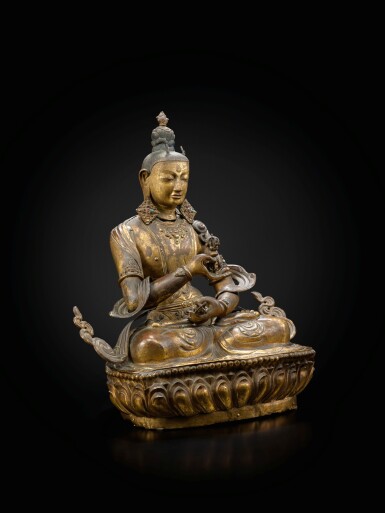
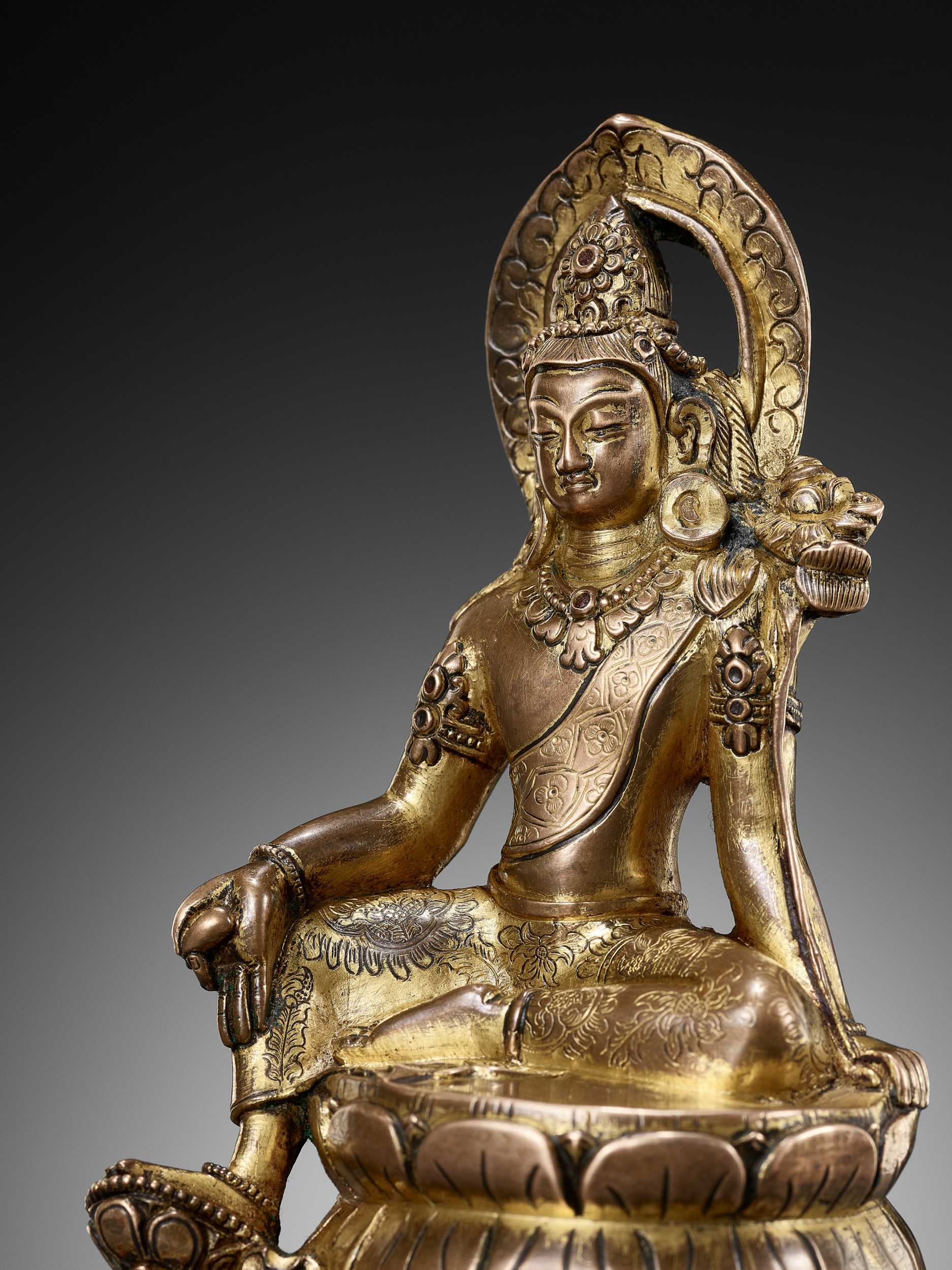
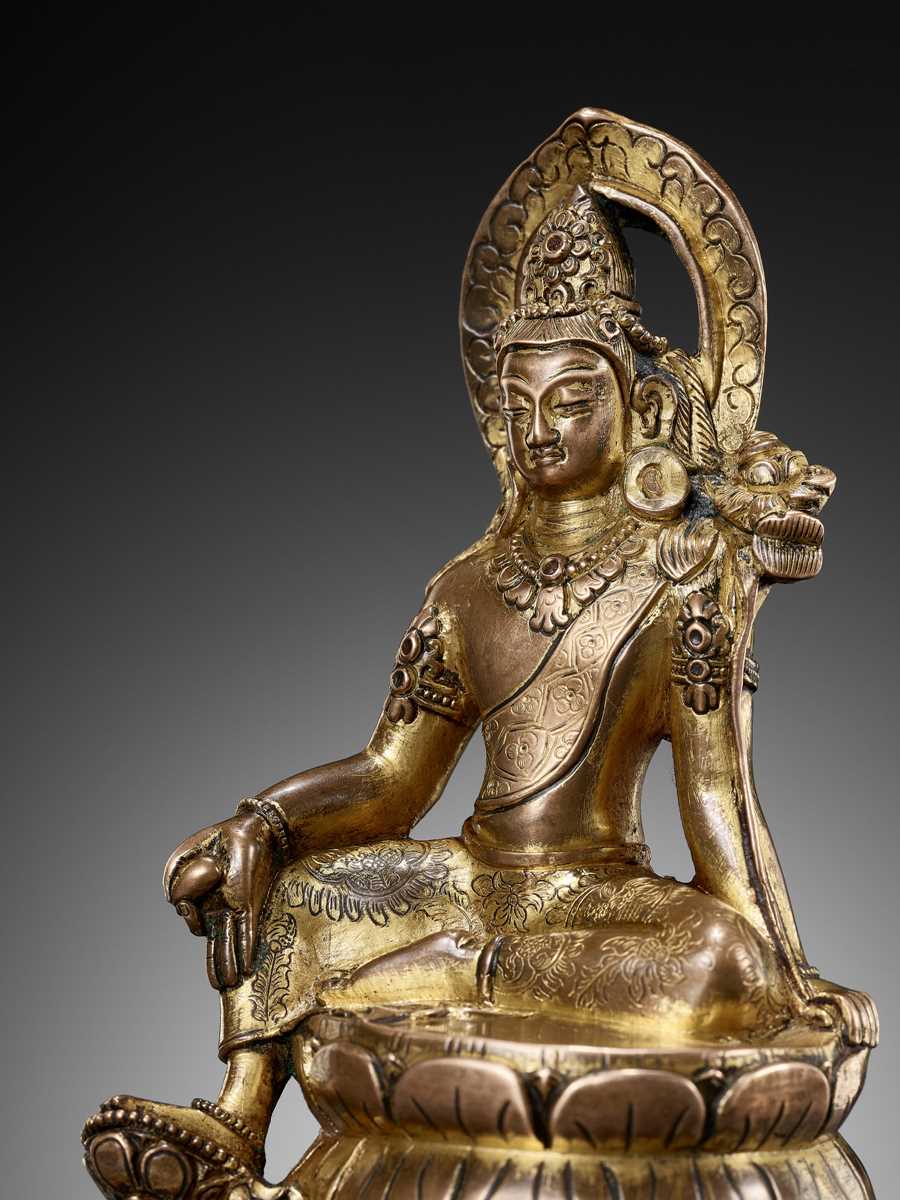







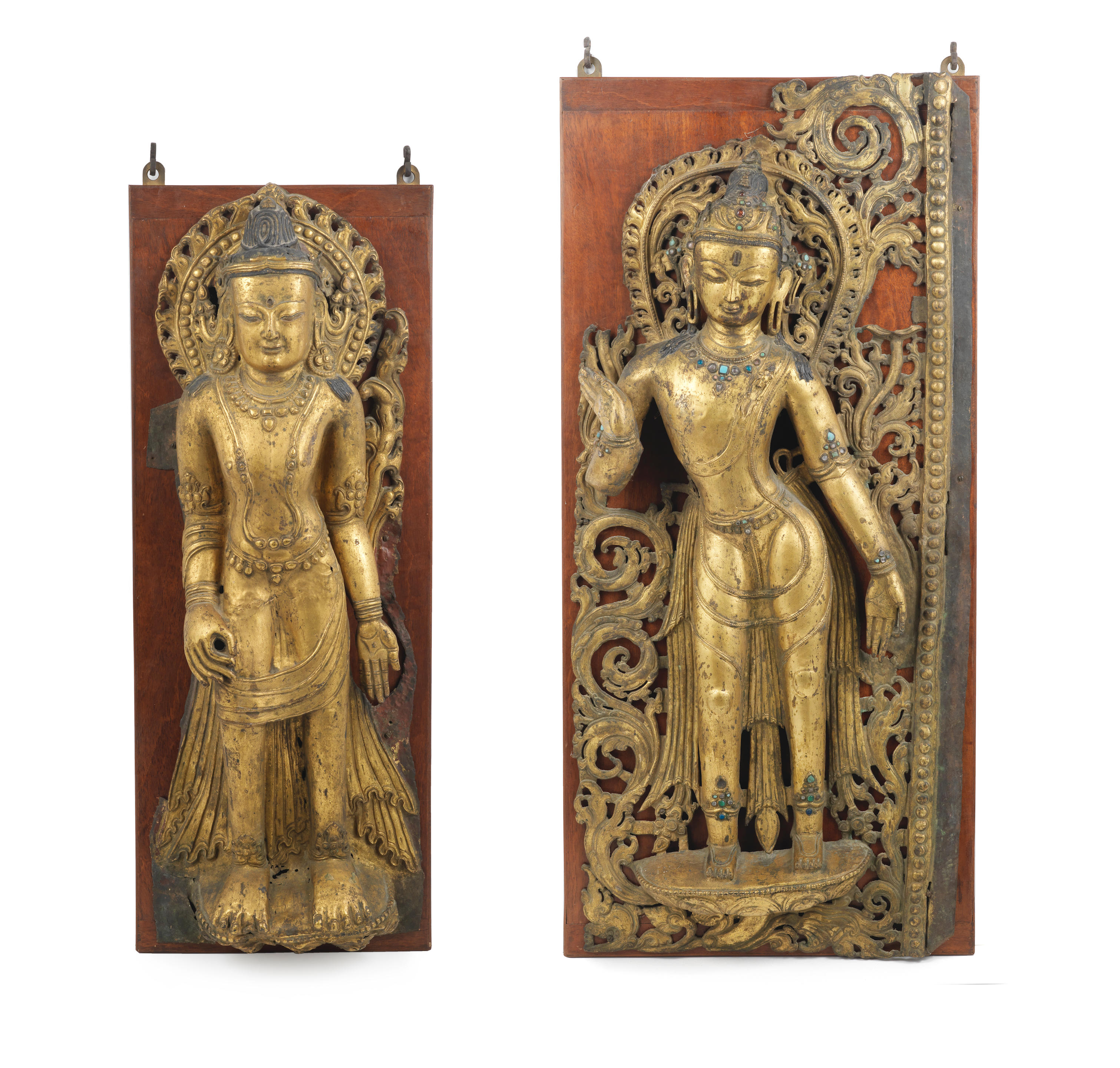
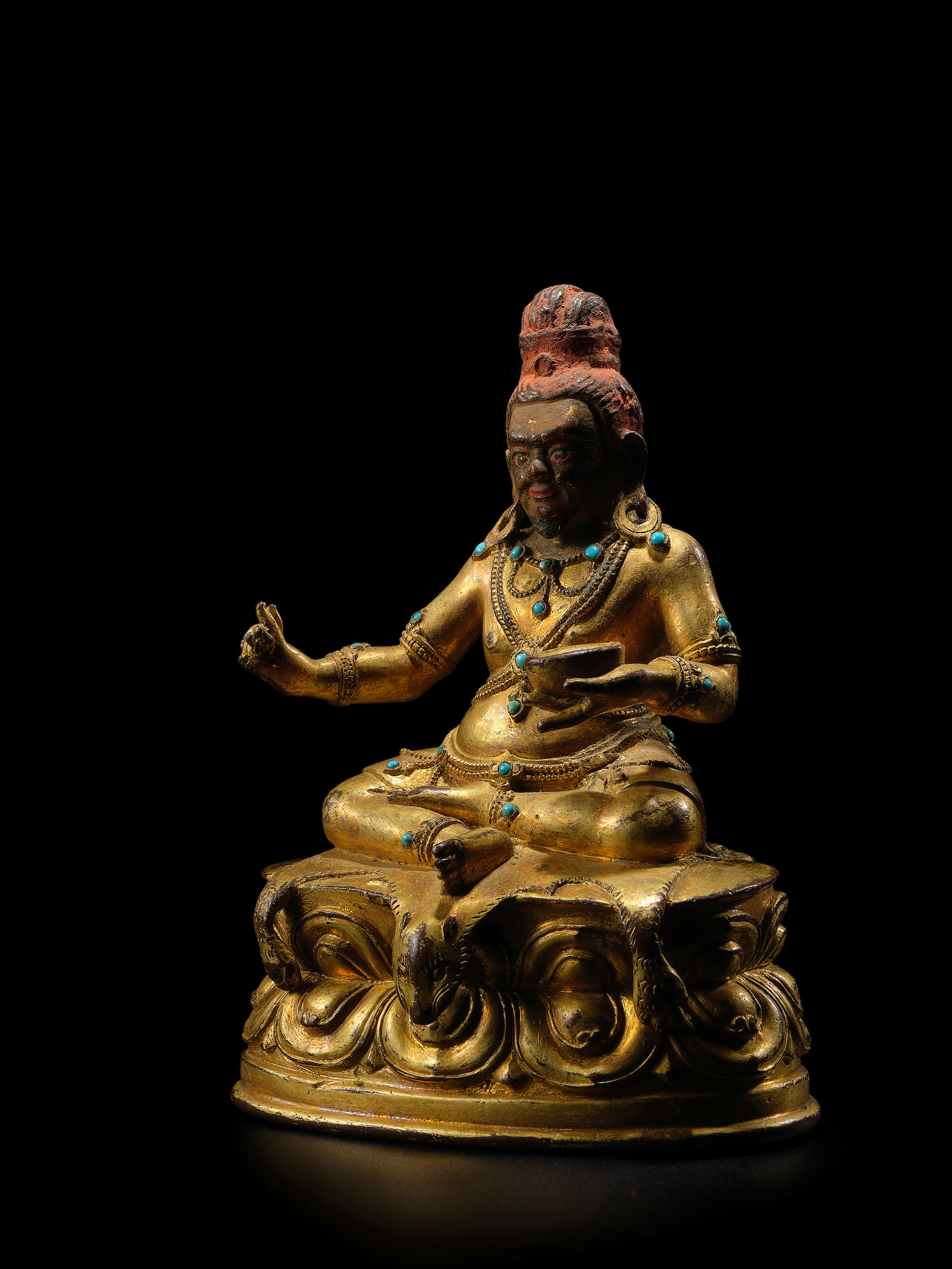

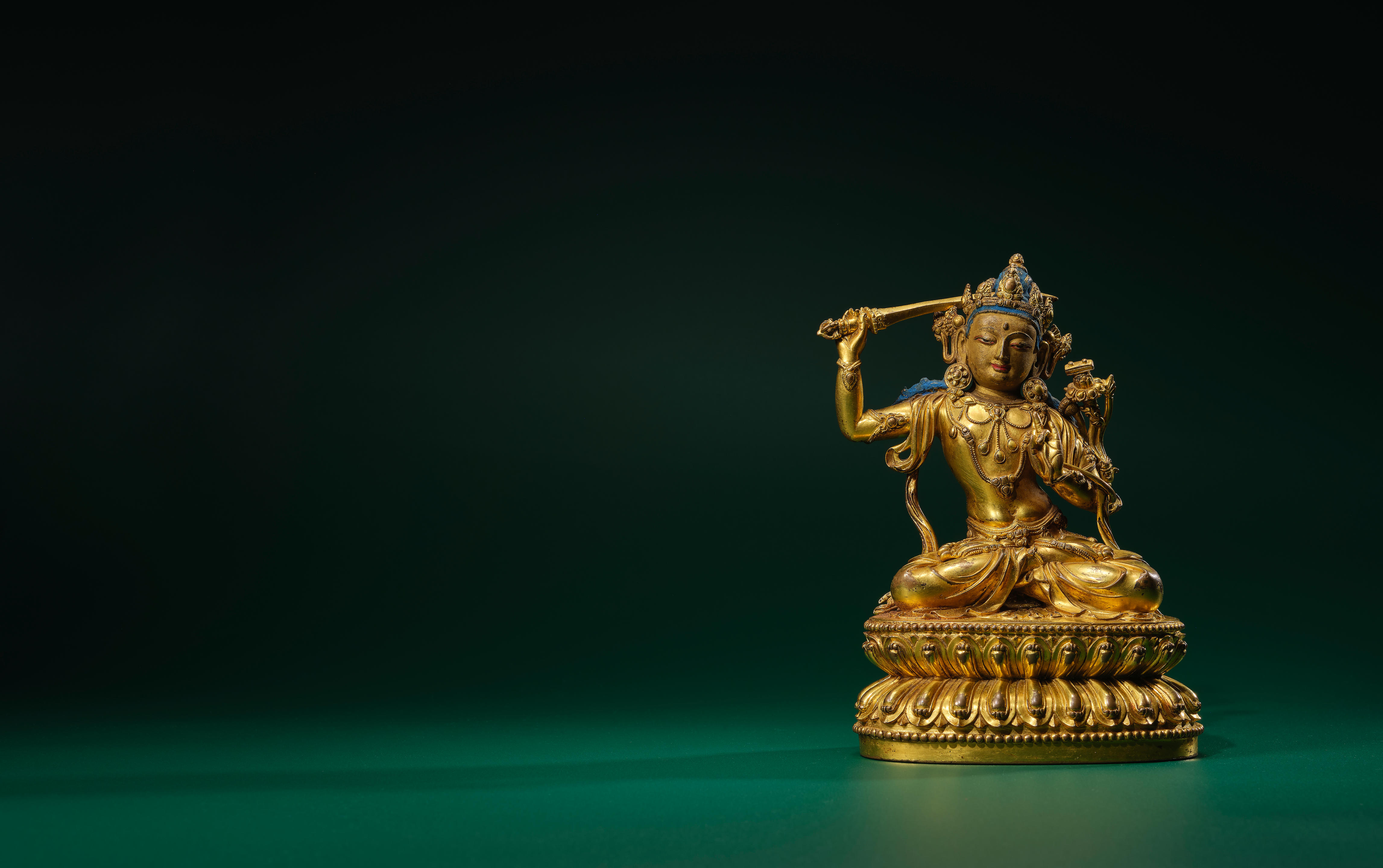
Testen Sie LotSearch und seine Premium-Features 7 Tage - ohne Kosten!
Lassen Sie sich automatisch über neue Objekte in kommenden Auktionen benachrichtigen.
Suchauftrag anlegen